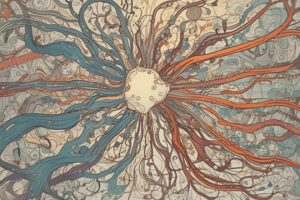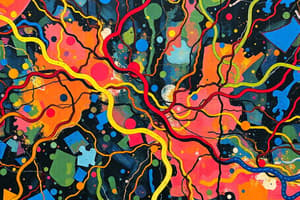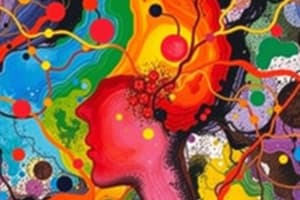Podcast
Questions and Answers
What symptoms are indicative of disruption in the tuberoinfundibular pathway due to antipsychotic medications?
What symptoms are indicative of disruption in the tuberoinfundibular pathway due to antipsychotic medications?
- Restlessness and inability to sit still
- Auditory hallucinations
- Tremors and rigidity
- Elevated prolactin levels (correct)
Which positive symptom is most commonly associated with psychotic disorders?
Which positive symptom is most commonly associated with psychotic disorders?
- Delusions of infidelity
- Visual hallucinations
- Auditory hallucinations (correct)
- Somatic delusions
Which of the following is NOT a likely consequence of antipsychotic treatment?
Which of the following is NOT a likely consequence of antipsychotic treatment?
- Difficulty conceiving
- Galactorrhea
- Weight gain (correct)
- Menstrual irregularities
What is primarily associated with positive symptoms of schizophrenia?
What is primarily associated with positive symptoms of schizophrenia?
What type of hallucination is likely to suggest an organic problem rather than a psychotic disorder?
What type of hallucination is likely to suggest an organic problem rather than a psychotic disorder?
Which of the following is a potential side effect associated with the nigrostriatal pathway?
Which of the following is a potential side effect associated with the nigrostriatal pathway?
What characterizes akathisia as a side effect of antipsychotics?
What characterizes akathisia as a side effect of antipsychotics?
Which dopamine pathway is involved with social withdrawal and cognitive deficits in schizophrenia?
Which dopamine pathway is involved with social withdrawal and cognitive deficits in schizophrenia?
In differentiating among psychoses, which condition requires at least one positive symptom for a diagnosis of schizophrenia?
In differentiating among psychoses, which condition requires at least one positive symptom for a diagnosis of schizophrenia?
What is a characteristic feature of the mesolimbic pathway in relation to psychosis?
What is a characteristic feature of the mesolimbic pathway in relation to psychosis?
Which of the following statements about dopamine pathways is accurate regarding antipsychotics?
Which of the following statements about dopamine pathways is accurate regarding antipsychotics?
What abnormal movement is specifically referred to as the 'Thorazine shuffle'?
What abnormal movement is specifically referred to as the 'Thorazine shuffle'?
Which characteristic is associated with schizophrenia but not defined only by it?
Which characteristic is associated with schizophrenia but not defined only by it?
Which best describes the role of newer antipsychotic medications?
Which best describes the role of newer antipsychotic medications?
Which of the following is NOT commonly associated with olfactory hallucinations?
Which of the following is NOT commonly associated with olfactory hallucinations?
What role does the tuberoinfundibular pathway play in relation to psychotic disorders?
What role does the tuberoinfundibular pathway play in relation to psychotic disorders?
What distinguishes brief psychotic disorder from other psychotic disorders?
What distinguishes brief psychotic disorder from other psychotic disorders?
Which of the following factors contributes to the diagnosis of schizophrenia?
Which of the following factors contributes to the diagnosis of schizophrenia?
Which of the following statements regarding schizoaffective disorder is correct?
Which of the following statements regarding schizoaffective disorder is correct?
What is a significant factor contributing to the development of psychosis according to the key takeaways?
What is a significant factor contributing to the development of psychosis according to the key takeaways?
In what way does dissociation serve as a coping mechanism?
In what way does dissociation serve as a coping mechanism?
Which type of psychosis is specifically attributed to a medical condition?
Which type of psychosis is specifically attributed to a medical condition?
What is a hallmark feature of tactile hallucinations?
What is a hallmark feature of tactile hallucinations?
Which distinguishes delusional disorder from other psychotic disorders?
Which distinguishes delusional disorder from other psychotic disorders?
What characterizes depersonalization in depersonalization/derealization disorder?
What characterizes depersonalization in depersonalization/derealization disorder?
Which type of dissociative amnesia involves no recall for events within a specific time frame?
Which type of dissociative amnesia involves no recall for events within a specific time frame?
Which of the following is a trigger for identity switching in dissociative identity disorder (DID)?
Which of the following is a trigger for identity switching in dissociative identity disorder (DID)?
What is a common symptom experienced in somatic symptom disorder?
What is a common symptom experienced in somatic symptom disorder?
Dissociative fugue is characterized by which of the following?
Dissociative fugue is characterized by which of the following?
What is a common aspect of dissociative amnesia?
What is a common aspect of dissociative amnesia?
What is a requirement for the diagnosis of dissociative amnesia?
What is a requirement for the diagnosis of dissociative amnesia?
Which of the following statements is true about somatic symptom disorder?
Which of the following statements is true about somatic symptom disorder?
Which disorder is characterized by the falsification of physical or psychological symptoms for the purpose of assuming the sick role?
Which disorder is characterized by the falsification of physical or psychological symptoms for the purpose of assuming the sick role?
What distinguishes Malingering from other somatic disorders?
What distinguishes Malingering from other somatic disorders?
In which age group is Illness Anxiety Disorder most commonly observed?
In which age group is Illness Anxiety Disorder most commonly observed?
What is a characteristic symptom of Conversion Disorder?
What is a characteristic symptom of Conversion Disorder?
What is a common behavior found in individuals with Factitious Disorder Imposed on Another?
What is a common behavior found in individuals with Factitious Disorder Imposed on Another?
Which of the following is a psychological factor affecting physical illness?
Which of the following is a psychological factor affecting physical illness?
What is a potential consequence of Factitious Disorder Imposed on Another?
What is a potential consequence of Factitious Disorder Imposed on Another?
Which of the following best describes the symptoms of Illness Anxiety Disorder?
Which of the following best describes the symptoms of Illness Anxiety Disorder?
Flashcards are hidden until you start studying
Study Notes
Dopamine and Psychosis
- Excess dopamine binding at D2 receptors in the mesolimbic pathway is strongly associated with psychosis.
- Psychosis can be caused by various factors, not just schizophrenia.
- Schizophrenia is the most common psychotic disorder.
Dopamine Pathways in Schizophrenia
- There are four main dopamine pathways in the brain: mesolimbic, mesocortical, nigrostriatal, and tuberoinfundibular.
- The mesolimbic pathway is involved with positive symptoms of schizophrenia.
- The mesocortical pathway is involved with negative and cognitive symptoms of schizophrenia.
- The nigrostriatal pathway is involved with extrapyramidal symptoms and tardive dyskinesia.
- The tuberoinfundibular pathway is involved with hyperprolactinemia.
Mesolimbic Pathway
- The “psychotic pathway” connects the ventral tegmental area (VTA) to the nucleus accumbens (reward center).
- Implicated in motivation, pleasure, and reward.
- Excess dopamine leads to increased pleasure, reward, and motivation as well as positive symptoms of schizophrenia (hallucinations, delusions).
- Implicated in all forms of psychosis.
Mesocortical Pathway
- Connects the VTA to the prefrontal cortex (PFC).
- Reduced dopamine leads to negative symptoms of schizophrenia (flat affect, cognitive deficits, social withdrawal, executive function impairment, and difficulty with appropriate expression of emotion/cognition, and problem solving).
- Negative symptoms are associated with poorer long-term outcomes.
- Antipsychotics can worsen negative symptoms by further reducing dopamine in this pathway.
Nigrostriatal Pathway
- Connects the substantia nigra to the striatum (motor control).
- Typically unaffected in schizophrenia.
- Antipsychotics can disrupt this pathway, leading to extrapyramidal symptoms (EPS), such as tremors, rigidity, akathisia, and the “Thorazine shuffle.”
- Deficiencies of dopamine in this pathway are implicit in movement disorders like Parkinson’s Disease.
Tuberoinfundibular Pathway
- Connects the substantia nigra to the hypothalamus (prolactin production).
- Typically unaffected in schizophrenia.
- Antipsychotics can disrupt this pathway, leading to hyperprolactinemia, galactorrhea, menstrual irregularities, and difficulty conceiving.
Antipsychotic Medications
- Aim to control dopamine activity in the mesolimbic pathway while minimizing effects on other pathways.
- Newer antipsychotics are generally better at achieving this balance.
Differentiating Among Psychoses
- Psychosis is a symptom, not a diagnosis.
- Identify the type of psychosis:
- Hallucinations are sensory perceptions without external stimuli.
- Auditory (most common in psychotic disorders).
- Visual (can be associated with psychotic disorders or organic conditions).
- Tactile, olfactory, and gustatory (more likely to have organic causes).
- Delusions are fixed, false beliefs despite evidence to the contrary or rational argument.
- Common types: mood or atmosphere, perception, memory, ideas, and awareness.
- Hallucinations are sensory perceptions without external stimuli.
Psychotic Disorders
- Schizophrenia: Chronic psychotic disorder with positive symptoms (hallucinations, delusions), negative symptoms, and functional impairment. Symptoms must last for at least 6 months.
- Schizoaffective Disorder: Meets criteria for both schizophrenia and a mood disorder (MDD, BPD I, BPD II).
- Schizophreniform Disorder: Symptoms of schizophrenia but for less than 6 months.
- Brief Psychotic Disorder: Psychotic symptoms lasting less than one month.
- Delusional Disorder: Persistent delusions without other psychotic symptoms.
- Substance-Induced Psychosis: Psychosis caused by substance use.
- Psychotic Disorder Due to a Medical Condition: Psychosis caused by an underlying medical condition (e.g., head injury, metabolic imbalance, organic lesion).
- Paraphrenia: Chronic psychotic disorder similar to schizophrenia but with better-preserved affect and functioning.
- Paraphrenia: Chronic psychotic disorder similar to schizophrenia but with better-preserved affect and functioning.
Introduction to Dissociation
- Dissociation is a disconnection between a person’s thoughts, memories, feelings, or sense of self.
- Everyone dissociates sometimes. It is not a disorder unless it disrupts social or occupational function.
- Normal vs. abnormal dissociation:
- Everyday examples (daydreaming, highway hypnosis).
- Therapeutic uses (hypnosis).
- Dissociation as a coping mechanism (trauma, accidents, crime victim).
Characteristics of Dissociative Disorder
- Abrupt onset and offset.
- Positive and negative disruptions:
- Positive: Experiences that shouldn’t be there (e.g., feeling detached from your body).
- Negative: Lack of experiences that should be there (e.g., memory loss).
- Triggered by psychological conflict or trauma.
- Impaired functioning or distress.
Types of Dissociative Disorders
- Depersonalization/Derealization Disorder:
- Depersonalization: Detachment from oneself (physical, cognitive, or emotional self).
- Derealization: Feeling that surroundings are unreal or that people around them are not real people.
- Begins in early childhood - almost always before age 16.
- Dissociative Amnesia:
- Inability to recall important personal information, usually related to trauma.
- Begins suddenly and often precipitated by severe stress.
- Types:
- Localized: No recall for events within a particular time frame.
- Selective: Certain portions of time are lost.
- Generalized: All experiences of the lifetime are forgotten.
- Continuous: Loss of all memory from a certain time to the present.
- Systematized: Loss of certain classes of information (e.g., everything about work).
- Dissociative Fugue:
- Sudden, unexpected travel away from home with amnesia for identity.
- May assume a new identity.
- Severe stressor -> sx commonly lasts a few hours or days.
- Recovery is sudden.
- Dissociative Identity Disorder (DID):
- Formerly known as multiple personality disorder.
- Presence of two or more distinct personalities with unique attributes (mood, perception, recall, control of thought and behavior).
- Often associated with severe childhood trauma.
- Each identity has unique characteristics (names, age, gender).
- Significant gaps in memory and personal information.
- Identity switching triggered by stress.
Somatic Symptom and Related Disorders
- Somatic Symptom Disorder:
- Distressing physical symptoms with no identifiable medical cause.
- Common symptoms: pain, shortness of breath, palpitations, abdominal problems.
- Sx DO NOT respond to treatment that are usually effective.
- Conversion Disorder:
- Altered voluntary motor or sensory function with no neurological explanation.
- Examples: Blindness, paralysis, seizures, deafness, diplopia, hallucinations, paralysis, dysphagia.
- Symptoms do not conform to anatomical patterns.
- Illness Anxiety Disorder:
- “Hypochondriac”.
- Healthy people with a serious fear of a life-threatening illness.
- Needs repeated reassurance.
- Preoccupation with having or acquiring a serious illness.
- High anxiety about health, even with minimal or no symptoms.
- Psychological Factors Affecting Other Medical Conditions:
- Mental health conditions (e.g., depression, anxiety) impacting physical health.
- Examples: Depression worsening chronic pain, and hallucinations interfering with treatment adherence.
Factitious Disorder
- Factitious Disorder Imposed on Self (Munchausen’s Syndrome):
- Deceptive falsification of physical or psychological symptoms for the purpose of assuming the sick role.
- Often have coincident personality disorders.
- May undergo unnecessary medical procedures.
- Factitious Disorder Imposed on Another (Munchausen’s Syndrome by Proxy):
- Falsification of symptoms in another person, typically a child, for the purpose of gaining attention or sympathy.
- Not too concerned when given bad news.
- Sx do not make sense.
- Typical tx do not work.
- Death rate = 10%.
Malingering
- Intentional fabrication or exaggeration of symptoms for external gain (e.g., financial compensation, avoiding work, drugs).
- VERY difficult to detect.
Studying That Suits You
Use AI to generate personalized quizzes and flashcards to suit your learning preferences.




